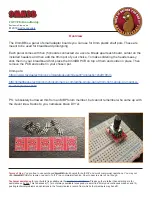
5
A biscuit baker has temperature controllers on his ovens that have a dial for
setting the temperature of his ovens. He would like to have a digital display
of his temperature for ease of monitoring. He has determined, by talking to the
temperature controller manufacturer, there is a 0 to 10 VDC voltage available
from the controller, that represents a temperature of approximately 0 to 600°F.
An Apollo DC voltage indicator is ideally suited to this application. It is
apparent that a standard range will not satisfy this requirement; therefore, field
scaling is required. The first thing that must be done is to determine what
division factor is required. Use the equation discussed in the text.
Division = (Maximum Output) x D.P.P. = (10) x 1000 = 16.7 (D.F.)
Factor (Desired Display) (600)
It can be seen that the division factor falls between 12 and 105
(See
“Scaling Connection Diagrams”)
. This is accomplished by connecting a
jumper between “÷10”
(Terminal 6)
and Terminal 10
(the 1.999 V basic input)
,
and a jumper between Terminal 9 and Terminal 8. Then, using 2 conductor
shielded wire to minimize noise pickup, the common of the temperature
controller output is connected to
“COMM.” (Terminal 3)
and the
“HIGH”
side of the output of the temperature controller is connected to “V
IN
”
(Terminal 7)
. The shield is also connected to
“COMM.”
(Terminal 3)
.
The Apollo is now ready to be calibrated. The baker has access to a portable
digital thermometer. So in this case, calibration will be accomplished by
causing the Apollo indicator to agree with the portable digital thermometer.
The baker sets his oven to his normal baking temperature of 375°F. He installs
the temperature probe in the oven and waits for it to reach equilibrium. After
the oven has stabilized, at its operating temperature, the baker simply adjusts
the
“coarse”
scaling adjustment, located at the rear of the unit, until the display
is close in value to that indicated on the digital thermometer. He then removes
the
“fine”
scaling access plug and adjusts the
“fine”
scaling adjustment until
the display agrees with the digital thermometer. He replaces the access plug to
keep dust out of the Apollo. The Apollo voltmeter now indicates the oven
temperature and the baker can monitor his temperature precisely.
1 2 3 4 5 6 7 8 9 10
11
5
VA
C
50/60H
Z
COMM.
÷ 1000
÷ 100
÷ 10
V
1.999V
IN
SCALE
ADJUST
OVEN
HIGH
COMM.
SHIELD
375
THERMOMETER
DIGITAL
TEMPERATURE MONITORING IN A BISCUIT BAKING OPERATION
TYPICAL VOLTAGE & CURRENT MEASUREMENT APPLICATIONS
VOLUME INDICATION
A manufacturer who uses vats of chemicals in his process has been using
the output of load cells, connected to a circuit that in turn drives a 1 mA DC
analog meter movement to display how full the vat is. The meter dial is
calibrated 0 to 1500 gallons.
An Apollo DC current indicator is ideally suited to this application. It is
apparent that a standard range will not satisfy this requirement and field
scaling is required.
It can be seen that the 1 mA for 1500 gallons can not be accomplished using
the 1.999 mA range; however, the maximum input of 1mA does not exceed
the maximum input on the 199.9 µA range, so this range is selected. This is
accomplished by connecting the jumpers as described in the “Scaling” section
[e.g. from “199.9 µA” (Terminal 8) to Terminal 11 and a jumper between
Terminal 10 and the “199.9 mV” basic input (Terminal 9)]
. Then, the Apollo
is connected in the circuit to replace the analog meter by connecting the
“199.9 µA”
(Terminal 8) where the “+” terminal of the analog meter was
connected, and connecting the
“COMM.”
(Terminal 3) where the “-” terminal
of the analog meter was connected.
The Apollo is now ready to be calibrated. The operator fills the vat until it
is completely full and he knows he has 1500 gallons. He then adjusts the
coarse scaling adjustment on the rear of the Apollo indicator until the display
reads approximately 1500. He then removes the
“fine”
scaling adjustment
access plug and adjusts the
“fine”
scaling adjustment until the display reads
exactly 1500. He replaces the access plug to keep dust and water out of the
Apollo. The Apollo current meter now indicates the exact number of gallons
in the vat. No decimal point is selected because the resolution is 1 gallon.
1 2 3 4 5 6 7 8 9 10
11
5
VA
C
50/60H
Z
COMM.
1.999A
199.9M
A
19.99M
A
1.999M
A
199.9U
A
SCALE
ADJUST
11
+
-
0 TO 1MA
EQUALS
0 TO 1500
VAT
LOAD
CELLS
199.9M
V























